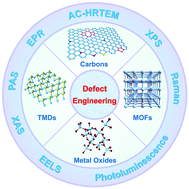Defect engineering and characterization of active sites for efficient electrocatalysis
Abstract
Electrocatalysis plays a decisive role in various energy-related applications. Engineering the active sites of electrocatalysts is an important aspect to promote their catalytic performance. In particular, defect engineering provides a feasible and efficient approach to improve the intrinsic activities and increase the number of active sites in electrocatalysts. In this review, recent investigations on defect engineering of a wide range of electrocatalysts such as metal-free carbon materials, transition metal oxides, transition metal dichalcogenides and metal–organic frameworks (MOFs) will be summarized. Different defect creation strategies will be outlined, for example, heteroatom doping and removal, plasma irradiation, hydrogenation, amorphization, phase transition and reduction treatment. In addition, we will overview the commonly used advanced characterization techniques that could confirm the existence and identify the detailed structures, types and concentration of defects in electrocatalysts. The defect characterization tools are beneficial for gaining an in-depth understanding of defects on electrocatalysis and thus could reveal the structure–performance relationship. Finally, the major challenges and future development directions on defect engineering of electrocatalysts will be discussed.

- This article is part of the themed collections: Recent Review Articles and 2021 Nanoscale HOT Article Collection


 Please wait while we load your content...
Please wait while we load your content...